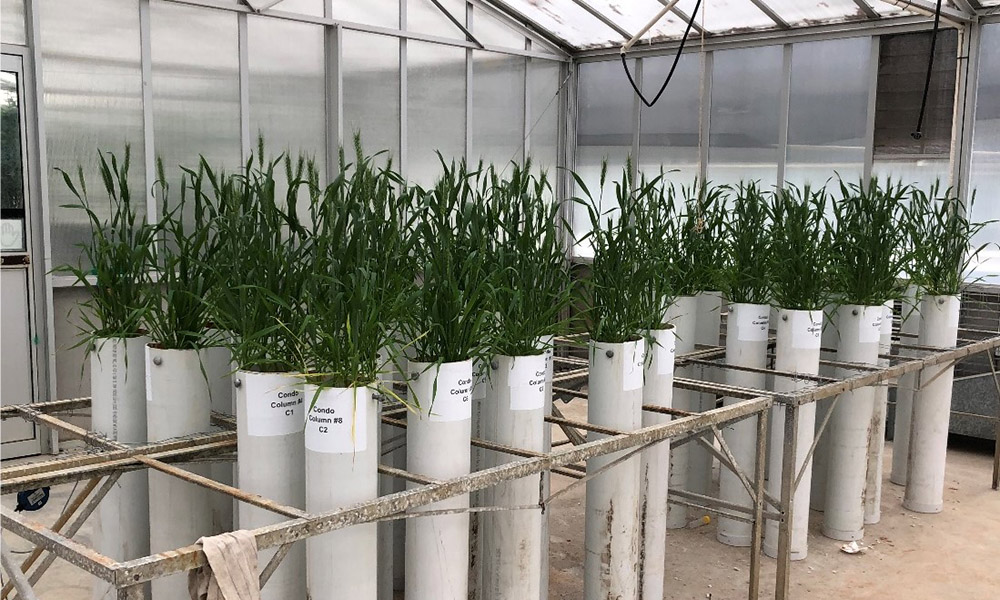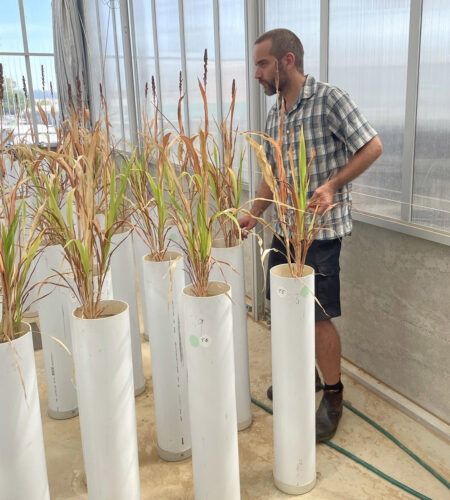Key points
- Many problem soils have constraints that limit plant performance. Constraints are often in the subsoil and are only identified by examining the full soil profile rather than topsoil tests alone.
- Plant performance improved in soils with multiple constraints when amendments supplying nitrogen and phosphorus were added to the subsoil.
- Organic amendments can have mixed outcomes. They can improve soil structure and supply a broad range of nutrients but may also increase salinity, depending on soil conditions and application rates. Their effectiveness depends on the condition of the surface soil – benefits are more likely where surface layers allow adequate aeration to the subsoil. Where surface structure is poor, adding organic matter can reduce root growth.
- Gypsum remains the most effective amendment for improving dispersive soils, but added nutrition is required to capitalise on improved soil structure.
The challenge
Australian soils commonly have multiple constraints that limit crop productivity. Constraints can include dispersion, acidity, nutrient deficiencies or toxicities, poor structure, and low organic matter. Such conditions restrict root growth, reduce water and nutrient uptake, and ultimately limit yield potential.
Conventional soil management typically focuses on the top 10 centimetres of soil. However, many constraints occur deeper in the profile and are only identified by examining the full root zone – not just surface soil testing.
Managing these constraints is not always straightforward. Some soils are inherently difficult to improve, particularly when multiple issues occur in different layers of the profile. While targeted amendments can help, it is often unclear which amendment will work best, or whether one amendment can address more than one constraint at once.
To improve outcomes, we need to better understand how different amendments affect soil properties and plant response – both in the short and long term. That understanding is critical to developing more effective and efficient management strategies for complex soils.
Our research
This project investigated whether applying inorganic and organic amendments to surface and subsoil layers can improve plant performance on soils with multiple chemical and physical constraints.
The work was based on detailed glasshouse and laboratory experiments using soils identified and supplied by six collaborating grower groups: Birchip Cropping Group (BCG), Riverine Plains and Wimmera Catchment Management Authority (WCMA) in Victoria, FarmLink and Central West Farming Systems (CWFS) in New South Wales, and Hart Field Site Group (HART) in South Australia.
Each group nominated a problem soil – one that had proven difficult to manage due to a range of physical or chemical constraints. These soils typically limited water entry into the profile or restricted root growth and exploration. Common issues included acidity, low fertility, compaction, sodicity, poor structure, waterlogging, and subsoil salinity. Soil samples were collected from three layers within each profile (Figure 1).

Glasshouse and incubation studies were used to determine whether amendments could overcome these constraints and to better understand how they influence soil properties and plant performance.
Phase 1 – Column studies (reconstructed soil profiles)
Initial soil column trials quantified the extent that individual soil constraints were limiting plant growth and assessed the effectiveness of different amendments. Amendments tested included gypsum and organic matter to address sodicity and poor structure, lime to correct acidity, manure or fertiliser to supply nutrients, and elemental sulphur to address alkalinity.
Phase 2 – Lab-based amendment tests
Phase 2 tested a range of amendment types and application rates on the chemical and physical properties of each soil layer. Properties measured included pH, salinity (electrical conductivity), concentrations of plant-available nutrients, aggregate stability, and the turbidity of the soil solution. Interactions between amendments were also assessed to help refine treatment combinations. These trials provided rate-response data and helped identify the most promising treatments.
Amendments tested in this phase included organic matter (chicken manure pellets and wheat straw pellets), lime, gypsum, elemental sulphur, reactive rock phosphate, and magnesium silicate. Application rates included 0, 50, 100 and 200% of industry-recommended rates.
Phase 3 – Mechanism studies
The most effective treatments from Phases 1 and 2 were applied to selected soils to investigate how the amendments improved plant performance (yield). Research focused on the mechanisms driving the observed responses, such as changes in soil properties, nutrient availability, and root growth. In one soil, the impact of amendments on soil biological function was also examined.

Research findings
Plant performance improved in soils with multiple constraints when amendments supplying nitrogen (N) and phosphorus (P) were applied to the soil. These nutrients, delivered through either organic or mineral sources, were most effective when targeted to the layers where constraints were limiting growth (i.e. the subsoil). In many cases, improved nutrition also stimulated root development (Figure 3), which contributed to better soil structure. However, structure alone was not enough to improve yield.
Organic amendments improved plant performance, particularly those supplying a broad range of nutrients such as N, P, sulphur (S), and potassium (K). Chicken manure pellets provided higher nutritional value than wheat straw pellets. However, similar or better plant growth was achieved using targeted subsoil application of mineral N and P fertilisers at equivalent nutrient rates.

Organic matter improved soil structure over time, with benefits becoming more noticeable after 12 months. These effects were enhanced by active plant growth. Structural improvement alone was not enough to increase yield – adequate nutrition was still required to improve plant performance.
Improved soil nutrition also boosted soil biological activity. Surface-applied manure and subsoil fertiliser increased the abundance of microbial genes involved in carbon, phosphorus, and nitrogen cycling.
Dispersion from sodicity was common across most soils studied. Gypsum was the most effective amendment for improving aggregation and soil structure, but yield benefits were only realised when nutrients were also supplied. Organic amendments slightly improved soil aggregation but were less effective than gypsum. Sulphur-based treatments improved structure, but both gypsum and sulphur sometimes increased soil salinity above optimal levels for plant growth.
Significance of findings
This research challenges the assumption that problem soils are inherently unproductive. In many cases, poor crop performance is due to soil limitations that can be overcome with amendment addition. Traditional topsoil testing and surface amendment strategies often miss deeper constraints, limiting the effectiveness of soil management. However, some constraints, such as salinity, are simply not responsive to amendments.
The findings highlight the need to rethink fertiliser placement strategies. Targeted delivery of nutrients, particularly N and P, to the subsoil may improve plant performance, even in soils with multiple physical and chemical constraints. This shift in approach could increase yield potential in soils previously considered too difficult to manage.
Importantly, the research reinforces the active role of plants in soil amelioration. Improved nutrition stimulated root growth, which in turn contributed to better soil structure and biological function.
The project also produced valuable data on amendment types and application rates, providing a foundation for improving soil models and decision-support tools. These insights can help refine future soil management strategies, ensuring amendments are better matched to soil conditions and constraints.
Next steps
Further work is required to:
- test the effectiveness of subsoil nutrient application under field conditions, including comparing organic and mineral nutrient sources applied at equivalent nutrient rates and assessing their relative impact on yield, soil condition, and biology.
- assess the longer-term impact of subsoil nutrition on crop yield, root growth, soil structure, and biological function across different soil types and seasons.
- refine amendment strategies to match amendment type to specific soil constraints, considering the interaction between soil properties, constraint type, and seasonal conditions.
- understand how plants interact with amendments and how long those effects persist in the soil.
The findings from this project guided treatment planning for the Soil CRC projects:
- 2.004 – Integrated solutions for accessing soil moisture
- 2.006 – Capitalising on established field trials for ameliorating (sub) soil constraints
- 3.005 – Diagnosis frameworks for multiple and complex soil constraints
- 3.006 – Optimising soil constraint management through computer-based learning and modelling

